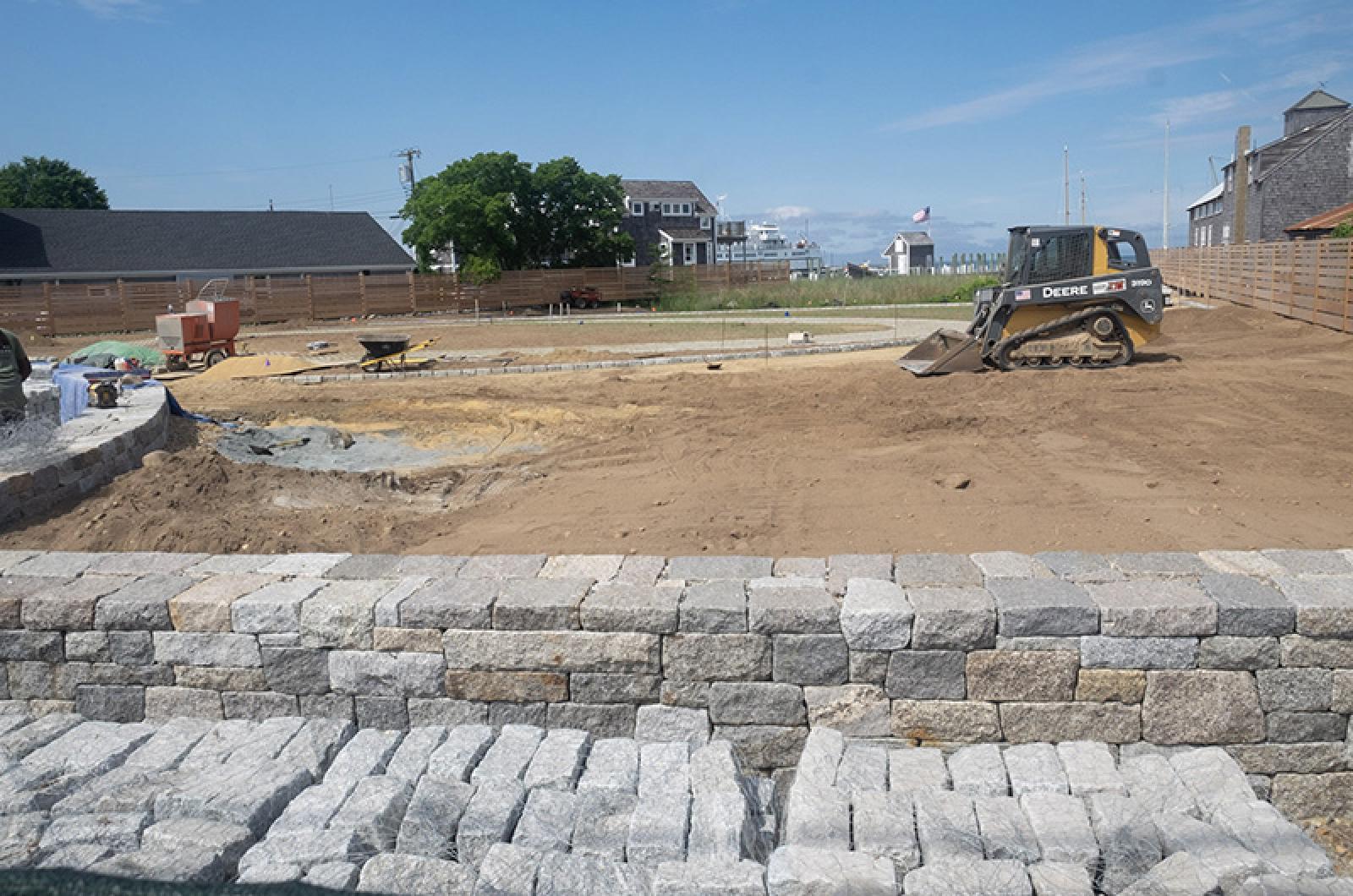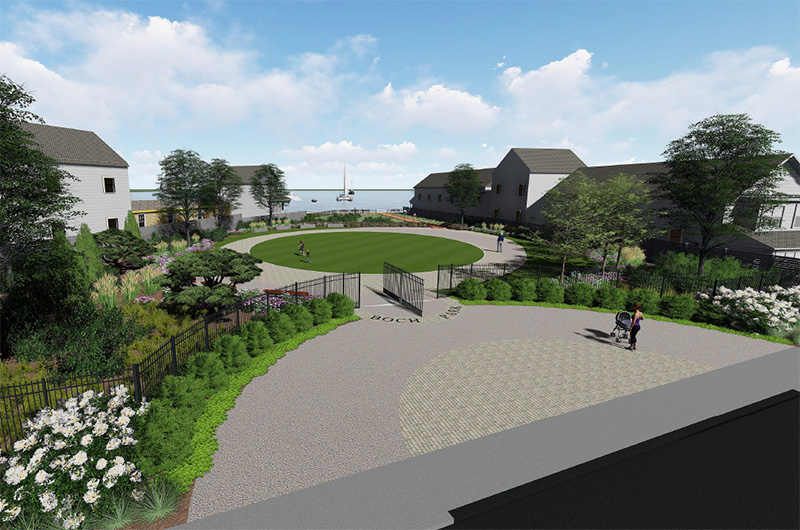Boch Park — the fenced-off, Beach Road construction site and creation of millionaire car salesman, philanthropist and Edgartown homeowner Ernie Boch Jr. — has a new name.

“It’s Boch Gardens,” Mr. Boch told the Gazette in an interview this week. “I changed the name. And it’s coming out well.”
Eighteen months after the first stone was laid on a frigid January morning in 2019, the highly visible property nestled between a Brazilian steakhouse, a gas station and the iconic Gannon and Benjamin Marine Railway is almost finished. It has a new use, too.
“It really will be a sanctuary,” Mr. Boch said. “Some people hang pictures. You know what I mean? They have a picture and they hang it. What I do is I hang frames. I hang frames first, and then figure out the art that is going in it. It’s just a different school. Some people hang the picture, I hang the frame.”
According to town officials overseeing the property referred to in town records as Boch Park Inc. — a three-acre vacant lot on the historic spit of sand and working waterfront that connects Vineyard Haven to Oak Bluffs — it is no longer even a park. It is planned as a private bird sanctuary, which Mr. Boch hopes will be finished by fall.
The sanctuary, according to Mr. Boch, will remain private — a perfectly legal but nonetheless controversial touchpoint that has been hashed out with the town over nearly three years since the project’s inception in 2017.
Interviews with town officials and a review of public records relating to the project show how the project evolved during the permitting process from a parking lot to a park — and now finally to a bird sanctuary — despite pushback from the town over the details, including its attractiveness to birds, that would qualify it as such.
Meanwhile, the languorous construction process, delayed by Covid-19, continues to inch ahead daily. Mr. Boch said the project is coming at “significant” expense, although he declined to give an exact figure. The landscape architect is Island designer Kristen Reimann, and the project manager is Dan Clemmey.
Mr. Boch said his goal, broadly speaking, is to beautify Beach Road in the hope that other property owners will follow suit. To him, it does not matter that the harborfront land is commercially zoned or that the town would prefer it to be used for public access to the waterfront. He just wants it to look nice.
“It’s a private project that I’m doing, as part of my contribution to the beautification of Beach Road,” Mr. Boch said. “Beach Road is looking a little tattered. If you woke up in 1960, and basically yesterday, it looks basically the same. I’m trying to spruce it up a little.”
He added: “I’m not the beautification police. I’m just trying to inspire.”

According to land records, Mr. Boch’s father, Ernest J. Boch, bought the parcel in 1987 for $600,000. In 1999, it was transferred to an LLC called Boch Park Inc., with Mr. Boch taking full ownership after his father’s death in 2003. The land is currently assessed at $2,038,900.
Situated near the heart of the Five Corners intersection in Vineyard Haven, the property has been the source of various legal and zoning skirmishes between the Boch family and the town in recent years. At one point, the senior Mr. Boch wanted to operate valet parking on the site but was denied a permit by the planning board. The property lay dormant for years afterward.
Then in 2016, the younger Mr. Boch received a permit from former Tisbury building inspector Ken Barwick to demolish the dilapidated Entwistle building on the property, town records show. With the building gone, extensive plans began to emerge for a park on the site — again raising concerns about public use of the property.
On Oct. 20, 2017, Tisbury planning board chairman Ben Robinson sent a letter to Mr. Boch outlining the allowed zoning uses of the property.
Under the town’s specially-written working waterfront bylaw, “parks, esplanades, walkways and other pedestrian facilities that promote use and enjoyment of the water by the general public,” do not need a special permit from the planning board. But Mr. Robinson wanted further proof that the project would satisfy the “general public” section of the zoning bylaw. He requested a memorandum of understanding with the town, before any construction could proceed. But the Boch Park developers demurred, and in the summer of 2018 they came back before the conservation commission and planning board with a different plan. Instead of a park, the project would become a wildlife sanctuary — an allowed use under the town zoning bylaws that wouldn’t require a special permit. And as a bird sanctuary, it could be private as well.
“Essentially, from a zoning perspective, a sanctuary can be open, but it can be restricted, too,” said Tisbury planning board assistant Pat Harris.
But to build a sanctuary by right, developers need a final signoff from the town building and zoning inspector. And unsurprisingly, the prospect of a bird sanctuary at one of the busiest commercial intersections on the Island threw some town officials and wildlife conservationists for a loop.
In an August 13, 2018 letter to Mr. Barwick, Ms. Harris wrote that neither town conservation agent Jane Varkonda nor state ornithologist Dr. Andrew Vitz believed the plan in its current design and configuration constituted a bird sanctuary. Both officials wrote letters to that effect during the summer of 2018 as well, according to town records.
“Thanks for sending me the documents on the ‘bird sanctuary,’” Dr. Vitz wrote to the planning board. “I have reviewed them, and to me, the plan doesn’t seem to represent a bird sanctuary. I do acknowledge that many of the plants used in the landscaping would offer benefits to birds for foraging or resting (e.g. bayberry, winterberry, blueberry, viburnum spp), but there is a very high proportion of the area in the lawn that would not offer much (if any) benefit to native birds. Reducing the amount of lawn and including more native fruiting shrubs would increase the benefit to birds.”
Nonetheless, Mr. Boch received approval from Mr. Barwick later that fall. Construction began over the winter.
Mr. Barwick retired in 2019. No official documents exist explaining the changes to the property or the signoff by the former building inspector. Current building inspector Ross Seavey said that after consulting with town administrator Jay Grande and other town officials, he learned the plans were later altered in accordance with the conservation commission’s recommendations, although there are no records to that effect.
“Additional consultation was done after the sanctuary status issue was raised to address the concerns of the planning board and to ensure that the property would indeed be a sanctuary,” Mr. Seavey wrote in an email to the Gazette. “As far as I can tell, since Ken [Barwick] allowed the project to start and continue, he must have made a determination that the plan conformed with the zoning bylaw as a ‘wildlife refuge, bird sanctuary, nesting areas, or other wildlife habitat.’”
The project has also received an order of conditions from the conservation commission that generally relate to construction restrictions in the waterfront area.
Current renderings for the sanctuary include a wood fence along the sides of the property, a wooden boardwalk that goes up and over the dune area closer to the water, a wide variety of plantings and landscaping, and a small, general park space which includes a pervious stone paved circle. A six-foot aluminum fence will front the property on Beach Road. A portion of the property along the beach will have some public access.
“It’s a tip of the hat to a [Frank Lloyd] Wright design,” Mr. Boch said. “When you’re in Boch Gardens, the way it looks out, and the way you look in through the fence, it’s kind of cool.”
A bronze statue of Mr. Boch’s father remains possible, Mr. Boch said, but has been put on the back burner for now. “I might do a statue,” Mr. Boch said. “I was looking around. But a bronze statue is quite expensive.”
In an interview, Mr. Seavey, who inherited the plans after Mr. Barwick’s retirement, said that as the current zoning inspector he saw no immediate issues with the property as a sanctuary, and would likely honor Mr. Barwick’s determination.
“Obviously, a sanctuary isn’t going to be existing until it is all planted and constructed. So hard to say at this point. We’ll have to see when it’s all done,” Mr. Seavey said. “But barring a complete change in the project, I can’t really go back on it, if that’s what Ken determined.”
Mr. Boch said the project is about 85 per cent complete, and that with a few more plantings, and a few more stone cuts, he was confident it would get to the finish line. While the gardens remain private, Mr. Boch said he might be open to some public use once the project is done. But reflecting on the property’s long history and the arduous construction process, he simply expressed excitement about the plans finally becoming a reality.
“Every time that I passed [the parking lot], I said this is terrible, this is horrible, look at this place,” Mr. Boch said. “And originally I thought a park. But then, with the plantings, it’s more of a garden. I think even though I can’t name a goddamn tree on it, I think people will appreciate that. And understand what we did.”








Comments (40)
Comments
Comment policy »